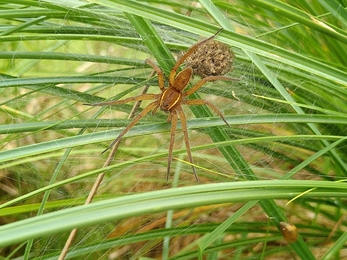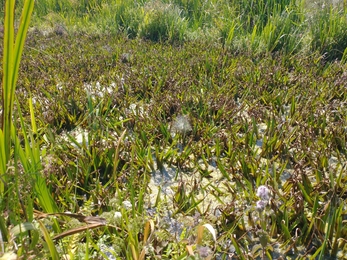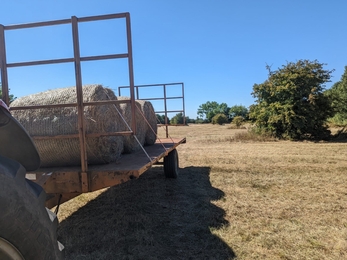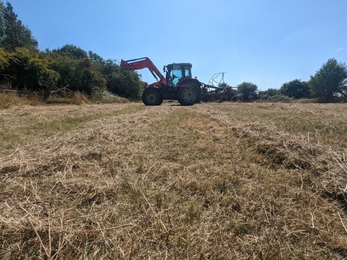Weekly wild news from our reserves - 12 August 2022
Fen raft spider webs amongst water soldier at Castle Mashes – Lewis Yates
Broads Assistant Warden Gavin snapped this lesser emperor dragonfly on Share Marsh at Carlton Marshes last weekend. Rarely seen on the reserve, this is likely to be a migrant from continental Europe.
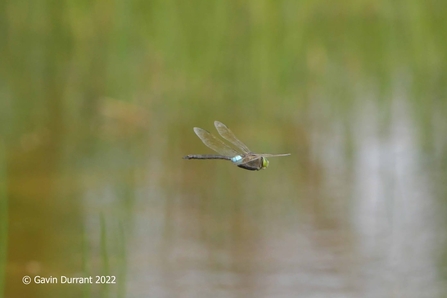
Lesser emperor dragonfly - Gavin Durrant
Fen raft spiders
Fen raft spiders (Dolomedes plantarius) continue to thrive at Castle and Carlton Marshes, with their nursery webs being easily visible in the dykes, if you look closely amongst the water soldier and reed. These large spiders hunt on the water's surface, the hairs on their front legs able to sense vibrations on the water or in the air. They can pursue their prey underwater as well, breaking the surface tension to continue the chase. Prey species commonly include smaller invertebrates such as pond skaters and dragonfly larvae, however, they have also been recorded taking small sticklebacks and adult dragonflies.
Wasp mimics
Wasp spiders are doing well at Carlton Marshes and Lound Lakes, with 100’s being spotted at Lound recently. The female wasp spider has yellow, black and white stripes, just like a common wasp. This keeps it safe from predators, even though it is not dangerous itself. Female wasp spiders build large orb webs in grassland and heathland and attach their silk egg-sacs to the grasses. The web has a wide, white zig-zag strip running down the middle, known as a 'stabilimentum', the function of which is unclear.
Lounging lizard
Usually seen basking in the sun, this common lizard at Lound Lakes has taken to the shade in the extremely hot weather!
Living up to its name, the common lizard is the UK's most common and widespread reptile; it is found across many habitats, including heathland, moorland, woodland and grassland. Also known as the 'viviparous lizard', the common lizard is unusual among reptiles as it incubates its eggs inside its body and gives birth to live young rather than laying eggs.
If threatened by a predator, the common lizard will shed its still-moving tail in order to distract its attacker and make a quick getaway. This leaves a scar behind, but it can regrow its tail, although it is usually shorter than the original.
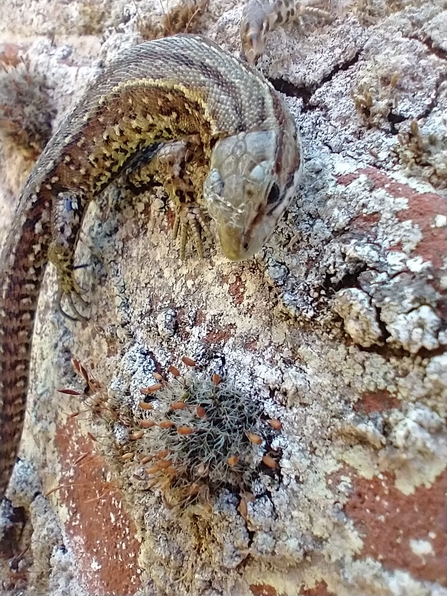
Common lizard taking shade on Fen Barn wall at Lound Lakes – Andy Hickinbotham
Wasps eating snake
Wasps don't just eat your picnic! They are important pollinators, pest controllers and omnivores that clear up all kinds of leftovers, like this recently deceased grass snake at Carlton Marshes.
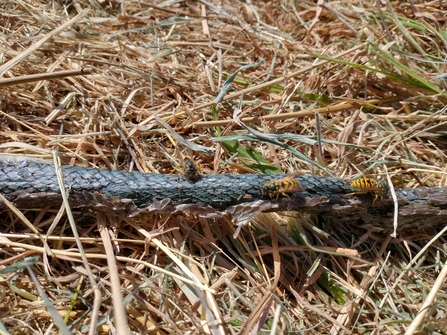
Wasps eating grass snake carcass – Lewis Yates
Monitoring water vole
The North East Suffolk Team spend a lot of time carefully placing rafts around the reserves to monitor for signs of water voles. These charismatic mammals like to sit and eat in the same place, so one sure sign is piles of nibbled grass and stems, showing a distinctive 45 degree, angled-cut at the ends. Another sign is 'latrines' of their rounded, cigar-shaped droppings. At Castle Marshes, the voles have ignored the rafts, preferring an old pipe that was part of the water control structures. At least we know they are doing well at Castle Marshes!
Water vole poo – Lewis Yates
Drought affects hay crop
The hot, dry weather has significantly affected our hay harvests this year. The hay cut at Wink’s Meadow usually reaps around ten bales, but this week’s cut only resulted in three bales. The cut hay is spread and turned at least twice before baling to ensure the seed is spread across the meadow, ensuring another spectacular display of flora next year.


